Famous low-calorie tempranillo grape
Tempranillo is one of the most popular Spanish grape varieties for making red wines with rich fruit flavors, vanilla and oak aromas. The drinks are characterized by medium to high tannins, moderate acidity and sugar content. The taste of the grapes depends on the climatic and soil characteristics of the growing region. The culture prefers mountainous areas with ample sunshine.
The content of the article
Description and characteristics of the Tempranillo grape variety
Tempranillo translated from Spanish means "early". The correct name of the grapes, taking into account the peculiarities of the Spanish language, is Tempraniyo. Winemakers noticed that the plant ripens earlier than Grenache, the traditional Spanish blending variety.
The crop is grown in Spain (Navarra and Rioja), Portugal, USA, Argentina and Australia. The dry and hot climate of these countries is ideal for the plant.
Origin story
On the territory of modern Spain, grapes have been grown since time immemorial. Archaeologists have discovered the fossilized remains of a vine, the age of which reaches 3 thousand years. In 1972, in the province of Burgos in northern central Spain, a mosaic was found depicting Bacchus (Dionysus), the god of wine. The find dates back to 800 BC.
Grape researchers believe that the Phoenicians brought the vine to the south of the Iberian Peninsula from the territory of modern Lebanon. It is she who is considered the progenitor of the Tempranillo variety.
In the 90s of the twentieth century, the culture gained popularity in many countries of the world due to its high adaptability to soil types and climate. Grapes have become a textbook technical variety. It is used to make port and red table wines.
Description of Tempranillo grapes
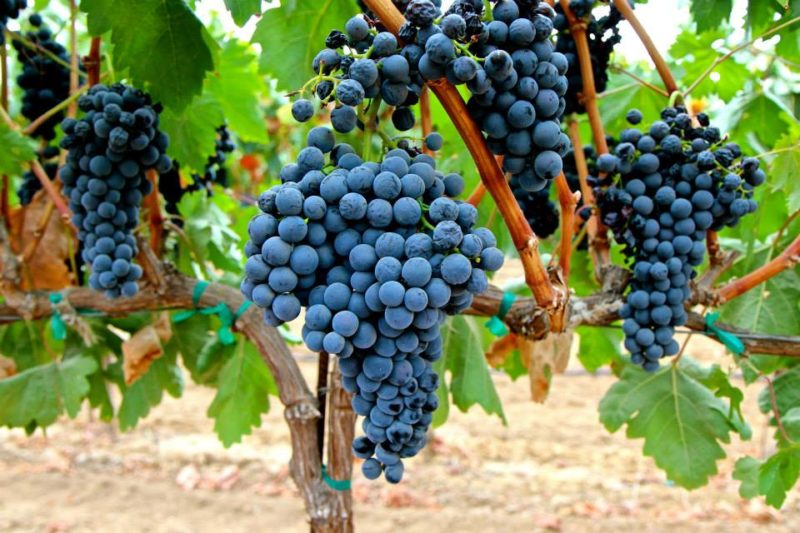
The Tempraniyo grape is a fast growing shrub with few foliage. The compact size allows you to thicken the planting, which has a positive effect on the yield. The bush can withstand a load of up to 20 shoots, each of which has 25 eyes.
Shoots are long, grow up to 7 m in length, are characterized by full maturation.
Reference! When cultivated in favorable conditions, the ripening rate is 85%.
The flowers are bisexual, do not need additional pollination. The leaf blade is large, wrinkled, with medium density pubescence. During the period of prolonged rains, the ovaries and flowers do not fall off, so the level of productivity does not decrease.
The bunches are compact, cylindrical-conical, weighing 600-700 g. The density is average and depends on climatic conditions. Young shrubs are prone to peas, especially in cold climates.
The berries are medium in size, 12–15 mm in diameter. The peel is of medium thickness, black-blue with an abundant matte bloom. The pulp is moderately firm and dark. Average weight - 6–8 g. Tasting taste is high. In nature, there is a mutational form of grapes called Tempranillo Blanco. The fruits have a green-yellow skin and are used to make white table wines.
The yield of the variety is consistently high with proper care: 4-5 kg per bush. The taste and quality of the berries depend on the growing conditions: during the period of prolonged rains, the fruits become watery, which has an extremely negative effect on the taste of the wine.Excessive moisture leads to a loss of taste and aroma of berries, so they are used for making budget wines or combined with other grape varieties.
The calorie content of Tempranillo grapes is low - 64 kcal per 100 g. This does not affect the quality of finished drinks. The fruits are rarely consumed fresh, except that they choose large clusters grown in sunny areas. The sugar content of the fruit reaches 16%, so the taste of the wine is bright and rich, and the rate of fermentation increases.
The acidity indicators are average - 9 g / l. Berries harvested in mountainous regions are characterized by a high acid content.
Drought tolerance in grapes is low - the culture needs abundant watering and mulching of the soil to retain moisture.
Advantages and disadvantages

The advantages of the variety:
- high productivity;
- low acid content;
- balanced taste of the drink.
Disadvantages:
- susceptibility to gray rot;
- sensitivity to spring and autumn frosts;
- dependence of taste on the region of cultivation;
- lack of immunity to pests.
Similar varieties
Tempranillo belongs to the autochthonous (local) varieties. The varieties of red technical grapes have similar characteristics: Grenache (Garnacha), Pinot Noir, Cabernet Franc, Malbec, Krasnostop, Codryanka.
Wine from Tempranillo
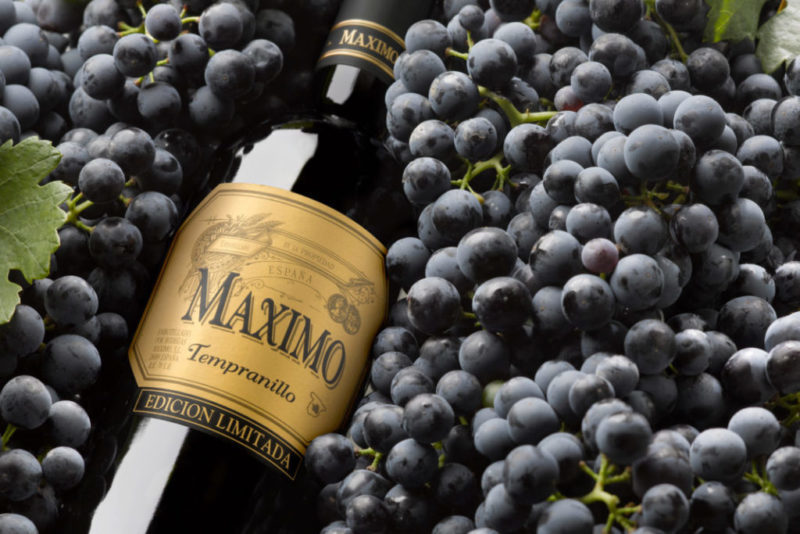
Tempranillo grapes contain anthocyanins, thanks to which the wines acquire a deep color, and the taste becomes tart and velvety.... The rich aroma of the drink meets the requirements of the consumer and compensates for the low taste profile.
Tempraniyo-based wines acquire notes of cherry, strawberry, black currant, prune, chocolate and tobacco. Berry notes prevail in young wine made with grapes from cold regions. The last three shades characterize drinks made from berries grown in warm climates.
The wine is aged in American oak barrels. This is the traditional choice of winemakers in Rioja - the taste of the drink takes on coconut and vanilla notes. At the Ribera del Duero, the drink is aged in French and second-hand oak barrels to give it a fruity taste and pleasant oak aroma.
Reference! From grapes warmed by the hot southern sun, an unusually tasty and rich wine with an optimal balance of acids and sugar is obtained. The finished drink has a bright fruity taste, soft, smooth and spicy aftertaste.
The lands of Australia and Argentina are ideal for growing Tempranillo. This grape produces wine with notes of cherry, tomato sauce and a small amount of tannins.
In Spain, wine aged in traditional oak barrels takes on an orange hue. Despite the rich taste, the structure remains light. Here it is served with sausages, jamon and grilled vegetables. In Italy, the drink is combined with pizza, lasagna, pasta with tomato sauces.
In Mexico, Tempranillo is served with tacos, burritos, nachos and chili. Other gastronomic combinations: grilled red peppers stuffed with rice, black pudding, bean stew, roast lamb with red currant jelly. The average alcohol content in the drink is 13-14.5%.
Popular wines:
- Vin Joven is a young, un aged in barrels with a short shelf life, distributed exclusively in Spain.
- Crianza - 2-year-old red (6 months - in American oak barrels).
- Reserva - red three years old, of which 1 year in oak barrels. The drink is characterized by an exquisite full taste.
- Gran Reserva - red five years old, of which 1.5 years in oak barrels. Rich tannin taste.
The main wine producers from Tempranillo: Portugal, Spain, Argentina, USA, Australia.
Name synonyms:
- Spain: Tinto Fino, Ojo de Libre, Sesibel, Tinto de Toro, Tinto Madrid, Tinto del Pei, Ul de Lièbre;
- Portugal: Tinta Aragonese, Aragones, Arinto Tinto, Aragonese, Tinta Roriz, Tinta de Santiago.
Planting seedlings

The Tempranillo grape variety is recommended for planting in higher elevations. The culture is whimsical to care for and is suitable for growing in regions with a warm climate. To improve health and protection, plants are treated against fungal infections, pests, and trellises are placed to support the vines.
High quality grapes with excellent taste are obtained when grown at an altitude of more than 700 m above sea level. The berries are illuminated from all sides by the sun's rays, and fluctuations in day and night temperatures ensure optimal acidity and sugar content of the fruit.
Reference! The Ribera del Duero is considered the best region for growing Tempranillo in the world. Here the daytime air temperature reaches + 40 ° С, the night temperature drops to + 16 ° С. Growers call Tempranillo the only variety that can adapt to such weather conditions.
The ideal soil for growing a crop is fertile, rich in limestone. The growing season is 125–135 days, but when grown in a Mediterranean climate, the berries ripen 2 weeks ahead of schedule. In industrial-scale vineyards, the maximum yield can be achieved 3-4 years after planting the seedlings.
Planting is carried out in early May, when the threat of return frosts disappears. During this period, plants receive an optimal amount of sunlight, which contributes to the rapid development of shoots and ovaries.
In Russia, Tempranillo is grown in Dagestan, Mordovia and the Krasnodar Territory. In the central regions, there is a tendency to peas, an increased risk of fungal infections and the death of bushes. According to statistics, in the Russian Federation, the variety is grown by no more than 0.5% of winegrowers.
Instructions for planting seedlings
For planting crops, sunny areas are chosen, protected from gusty winds. The soil is pre-plowed, the heavy loam is loosened with river sand. The optimal size of the pit: width - 70 cm, depth - 80 cm. The bottom is covered with broken brick or rubble, a layer of soil is added on top.
For planting, use healthy seedlings with a green top cut and a developed root system. Healthy roots are white. The planting material is kept in a growth stimulant solution for 30 minutes, then planted in pits, keeping a distance of 1.5 m. The roots are straightened, soil is poured on top, compacted with a palm and watered abundantly with settled water. Next to the seedlings, supports are driven in for the subsequent garter of the vine.
Read also:
Subtleties of care
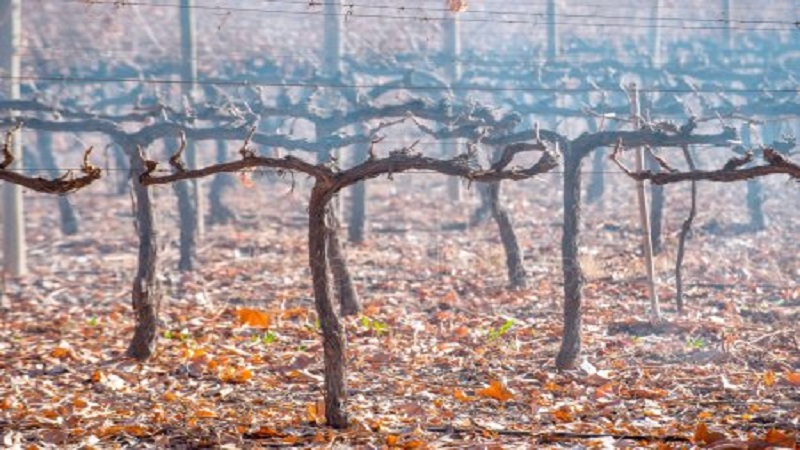
Tempraniyo is a capricious variety that requires a special approach to agricultural technology.
Highlights of grape growing:
- installation of supports and trellises for fixing the vine;
- sheltering bushes for the winter;
- preventive treatments three times a year;
- pruning vines to increase productivity and shape the crown;
- installation of an underground irrigation system;
- mulching of row spacings;
- introduction of organic matter and minerals.
Grapes need moderate watering at the beginning of development and abundant watering during dry periods. When planting in the center of the pit, a pipe for irrigation is dug in. This ensures the saturation of the root system with moisture. The earth crust is loosened after each irrigation to provide oxygen to the roots. Mulching reduces the frequency of loosening and retains moisture in the soil.
A month after planting, the grapes are fertilized with a solution of chicken manure in a ratio of 1:15. 14 days before flowering, the bushes are treated with the following solution: 4 g of sodium humate, 5 g of boric acid per 10 liters of water. 14 days after flowering, a nutrient solution is used for irrigation: 5 g of boric acid, 20 g of potassium magnesium, 4 g of sodium humate per 10 liters of water.
The variety is not frost-resistant and needs shelter for the winter. To do this, use straw, agrofibre, dense plastic wrap or spruce branches. The shelter is removed with the arrival of spring.
Pruning
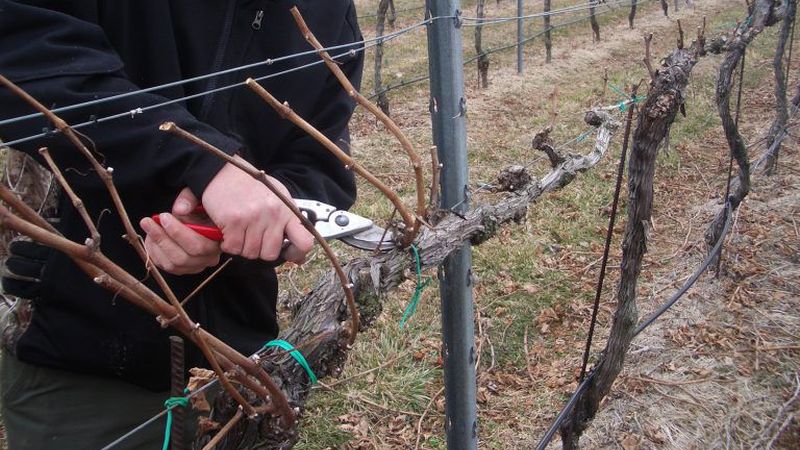
Vines are pruned every year in spring or fall. The stem ripens early, has long internodes. Grape growers recommend pruning with 6-8 eyes. In the spring, on healthy and strong bushes, up to 80% of last year's shoots are removed using a sharpened tool.
Bushes form mainly in the form of a "cup", common in the Iberian Peninsula. Local growers are confident that this molding allows the sun's rays to illuminate the berries from all directions. The taste of grapes from this only gets better, acquires rich fruity notes.
Disease and pest control
Tempranillo is susceptible to gray mold fungi, mildew and oidium. Timely preventive treatment reduces the risk of infections. Only contact fungicides are used in the work: "Thanos", "Horus", "Topaz" and "Tiovit Jet", "Ridomil", Bordeaux liquid, colloidal sulfur.
In case of infection, a sulfur solution is used (100 g per 10 l of water). Bushes are treated in the evening or in cloudy weather at least 3 times every 10 days.
Important! Sulfur is used at air temperatures above + 20 ° C. At low values, the grapes are treated with "Switch", "Strobi", "Cumulus DF" preparations.
The most dangerous pest of culture is considered to be phylloxera, or grape aphid living on the rhizome. It spreads with lightning speed and leads to the death of bushes. The main sign of infection is growths on the roots.
To exterminate the insect, pyrethroids ("Cypermethrin", "Deltamethrin"), organophosphorus compounds ("Metaphos", "Tiofos"), neonicotinoids ("Aktara") are used, since folk remedies do not provide the desired result. Biological products such as Bitoxibacillin and Fitoverm are highly effective and safe for humans and the environment.
Harvesting and storage
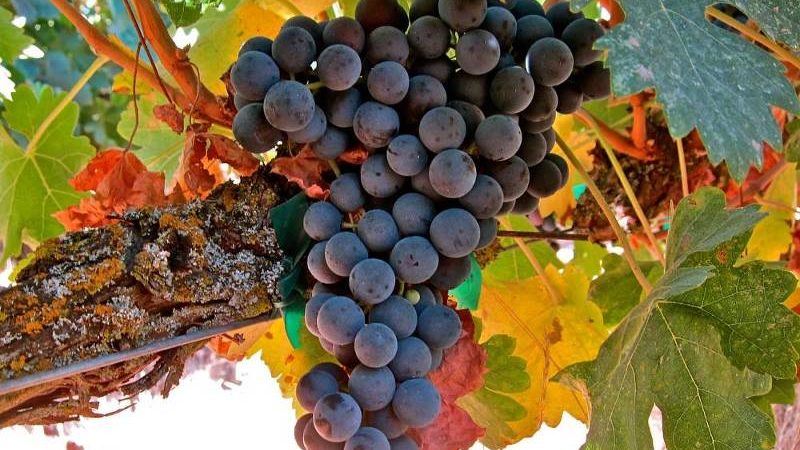
The bunches are trimmed with a sharp tool in dry weather and immediately sent for recycling. Technical grape varieties are not stored for a long time and are used mainly for making wine.
Read also:
Conclusion
Tempranillo is an ancient dark grape native to the Iberian Peninsula. The culture is characterized by an early ripening period. Small berries with almost black skin and dark, dense and juicy pulp have a balanced taste. Red table wines, port with a bright fruit taste and aroma are made from the fruits. Aging in oak barrels has a beneficial effect on the taste of the drink.
Tempranillo is whimsical in care and needs timely watering, organic and mineral fertilizing, pruning and shaping the bush in the form of a "cup". Preventive fungicide treatments reduce the risk of contracting fungal infections. To destroy the dangerous pest, phylloxera use insecticides and biological preparations.